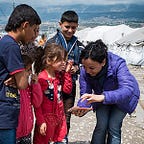Integrated Programming and Population Displacement: Addressing the Complexities of Migration through Prevention and Principled Response
Background & Concept Note
The World Food Programme (WFP) and Partners are increasingly called on to address food insecurity in cases of forced displacements including cross-border migration. This involves not only helping to address the root causes of forced displacement but also providing assistance to vulnerable mobile populations through a principled approach.
Persistent conflicts, climate shocks and food insecurity have driven millions of people to migrate away from their communities. There are more displaced today than at any time since World War II. Today there are almost 71 million forcibly displaced people in the world — 41 million internally displaced, 26 million refugees and 3.5 million asylum seekers.[1] Migration is also becoming an increasingly desperate act with millions of people choosing to move out of immediate distress despite the known risks of abuse, abduction, and even death. Studies have indicated that countries with the highest level of food insecurity, coupled with armed conflict, have the highest levels of outward migration. Food insecurity has been identified as a critical ‘push’ factor driving international migration.
Further, the act of migration itself can cause food insecurity, given the lack of income opportunities and adverse travel conditions along the journey, in addition to the high costs associated with travel. Migrants in journey are vulnerable to exploitation, depletion of individual and family resources and lack access to essential services. Between 2014 and 2019 some 34,000 migrant fatalities have occurred (IOM 2019). Responding to the needs of mobile populations is complicated and risky, and often with little political support. Humanitarian actors are often faced with the complexities of responding in a principled manner to those in need, while managing the expectations of host communities, governments and donors.
Objective
“Integrated Programming and Population Displacement: Addressing the Complexities of Migration through Prevention and Principled Response” aims to bring partners together around a unified advocacy and operational agenda which holds vulnerable migrants at the centre of the discussion.
Outline
Drawing from recent experience, discussion will also encompass the challenge we face to provide migrants and host communities with needs based assistance in countries of transit — particularly those affected by conflict and violence. The outcome will be a common understanding of critical issues facing organizations responding to food security needs associated with migration and a determination of common advocacy points to strengthen partnership on this issue.
Studies that explore the linkages between food security and emigration with a view to understanding the drivers of migration and possible programmatic responses are offered for consideration.
- UNHCR — Figures at a Glance
- AT THE ROOT OF EXODUS: Food security, conflict and international migration; WFP, 2017
- HUNGER WITHOUT BORDERS. The hidden links between Food Insecurity, Violence and Migration in the Northern Triangle of Central America. An exploratory study; IOM, LSE, OAS, WFP 2015
- FOOD SECURITY AND EMIGRATION. Why people flee and the impact on family members left behind in El Salvador, Guatemala and Honduras; IDB, IFAD, IOM, OAS, WFP, 2017.
